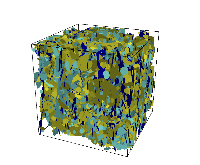Modeling flow and transport in fracture networks using graphs
- Los Alamos National Laboratory (LANL), Los Alamos, NM (United States)
Fractures form the main pathways for flow in the subsurface within low-permeability rock. For this reason, accurately predicting flow and transport in fractured systems is vital for improving the performance of subsurface applications. Fracture sizes in these systems can range from millimeters to kilometers. Although modeling flow and transport using the discrete fracture network (DFN) approach is known to be more accurate due to incorporation of the detailed fracture network structure over continuum-based methods, capturing the flow and transport in such a wide range of scales is still computationally intractable. Furthermore, if one has to quantify uncertainty, hundreds of realizations of these DFN models have to be run. To reduce the computational burden, we solve flow and transport on a graph representation of a DFN. We study the accuracy of the graph approach by comparing breakthrough times and tracer particle statistical data between the graph-based and the high-fidelity DFN approaches, for fracture networks with varying number of fractures and degree of heterogeneity. Due to our recent developments in capabilities to perform DFN high-fidelity simulations on fracture networks with large number of fractures, we are in a unique position to perform such a comparison. We show that the graph approach shows a consistent bias with up to an order of magnitude slower breakthrough when compared to the DFN approach. We show that this is due to graph algorithm's underprediction of the pressure gradients across intersections on a given fracture, leading to slower tracer particle speeds between intersections and longer travel times. We present a bias correction methodology to the graph algorithm that reduces the discrepancy between the DFN and graph predictions. We show that with this bias correction, the graph algorithm predictions significantly improve and the results are very accurate. In conclusion, the good accuracy and the low computational cost, with O(104) times lower times than the DFN, makes the graph algorithm an ideal technique to incorporate in uncertainty quantification methods.
- Research Organization:
- Los Alamos National Laboratory (LANL), Los Alamos, NM (United States)
- Sponsoring Organization:
- USDOE
- Grant/Contract Number:
- AC52-06NA25396; 20170103DR
- OSTI ID:
- 1427375
- Alternate ID(s):
- OSTI ID: 1425242
- Report Number(s):
- LA-UR-17-25905; 2470-0053 (Electronic)
- Journal Information:
- Physical Review E, Vol. 97, Issue 3
- Country of Publication:
- United States
- Language:
- English
Web of Science
Robust system size reduction of discrete fracture networks: a multi-fidelity method that preserves transport characteristics
|
journal | September 2018 |
Model reduction for fractured porous media: a machine learning approach for identifying main flow pathways
|
journal | March 2019 |
Partitioning Dynamics of Gravity‐Driven Unsaturated Flow Through Simple T‐Shaped Fracture Intersections
|
journal | August 2019 |
Quantifying Topological Uncertainty in Fractured Systems using Graph Theory and Machine Learning
|
journal | August 2018 |
Similar Records
Efficient Monte Carlo With Graph-Based Subsurface Flow and Transport Models
Machine learning for graph-based representations of three-dimensional discrete fracture networks











